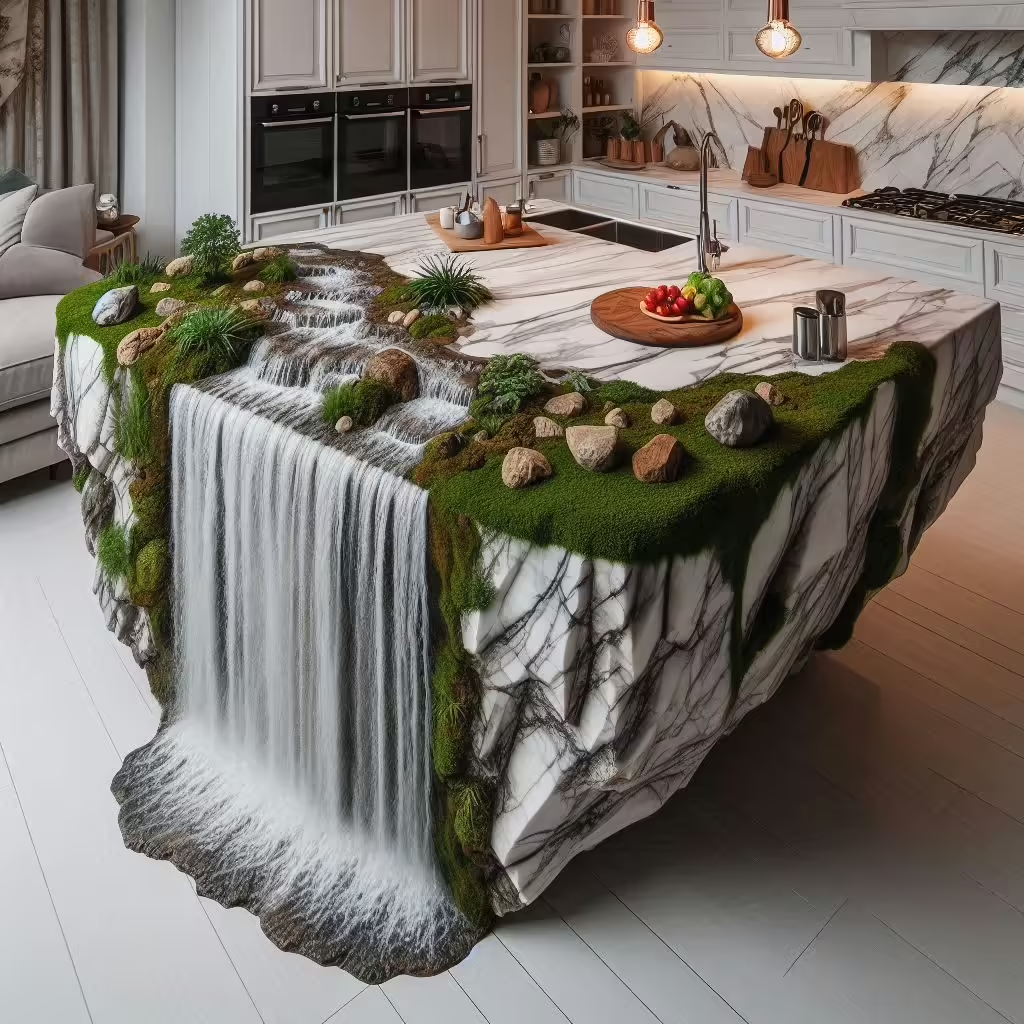A kitchen is often the heart of a home, a space where family and friends gather to cook, dine, and socialize. Among the various design trends, the “Waterfall-Shaped Kitchen Island” stands out as a favorite for modern homeowners and interior designers. This blog post delves into everything you need to know about this stunning kitchen feature—from design inspiration to practical benefits.
What Is a Waterfall Shaped-Kitchen Island?
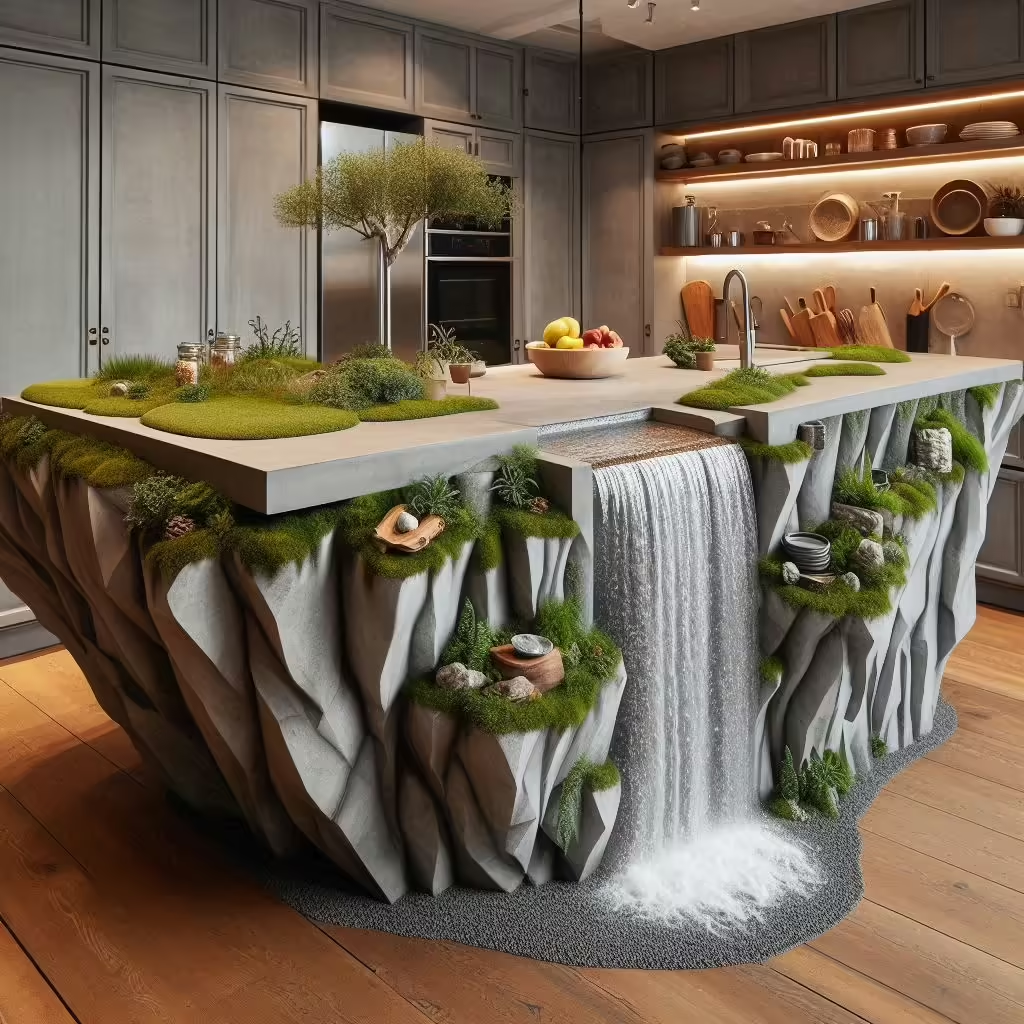
A waterfall-shaped kitchen island is a type of countertop design where the surface material extends vertically down the sides of the island, creating a continuous “waterfall” effect. Unlike traditional kitchen islands, which have a distinct top and sides, a waterfall island seamlessly integrates the top and sides with a smooth, uninterrupted flow. This design approach adds a sense of luxury and modernity to the kitchen, making it a striking focal point in any home.
Why Choose a Waterfall-Shaped Kitchen Island?
Modern Aesthetic Appeal
The waterfall-shaped kitchen island is synonymous with modern, sleek design. The continuous lines and seamless edges create a minimalist look that is both elegant and timeless. It’s perfect for homeowners who want to make a bold design statement in their kitchen.
Durability and Protection
Waterfall edges protect the base of the island from wear and tear. The continuous material, often made of stone, quartz, or granite, provides a durable surface that can withstand daily use. It also helps protect the cabinetry underneath from spills, scratches, and bumps.
Increased Functionality
A waterfall-shaped kitchen island is not just about looks. It can also serve multiple functions. The extended surface area can be used for extra seating, food preparation, and serving. The vertical sides provide additional opportunities for integrating storage solutions such as cabinets or shelves.
Versatility in Design
Whether your kitchen leans towards a modern, rustic, or traditional style, a waterfall-shaped kitchen island can be adapted to suit your aesthetic. The choice of material, color, and finish can dramatically change the look of the island to match your kitchen design.
Materials for a Waterfall-Shaped Kitchen Island
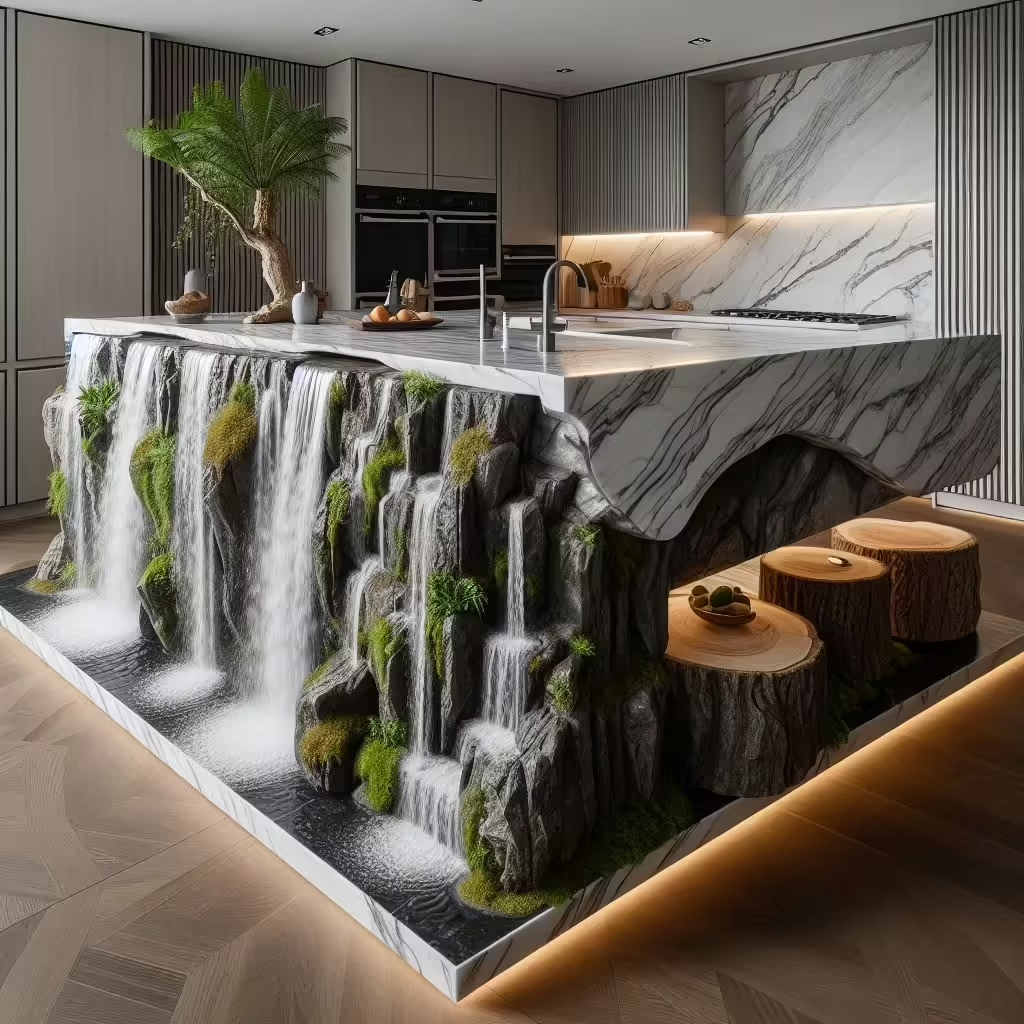
Quartz
Quartz is a popular material for waterfall kitchen islands due to its durability, low maintenance, and variety of colors and patterns. It’s non-porous, making it resistant to stains and easy to clean—ideal for a kitchen environment.
Granite
Granite offers a natural, luxurious appearance with unique patterns and colors. Each slab is unique, providing a one-of-a-kind look for your waterfall island. Granite is also heat and scratch-resistant, though it does require periodic sealing to maintain its appearance.
Marble
Marble is known for its classic beauty and luxurious appeal. Its veining patterns can create a dramatic waterfall effect, making the island a stunning centerpiece. However, marble is more porous than quartz and granite, requiring careful maintenance to prevent staining.
Concrete
For an industrial and contemporary look, concrete can be a great choice. It can be customized with different textures, colors, and finishes to create a unique waterfall island. Concrete is durable, but it may need to be sealed to prevent staining.
Wood
Wood adds warmth and a natural element to the kitchen. A waterfall island made of wood can bring a rustic or modern edge to the space, depending on the type of wood and finish used. While wood requires more maintenance than stone, it offers a distinct look that can be incredibly charming.
Design Ideas for Waterfall-Shaped Kitchen Islands
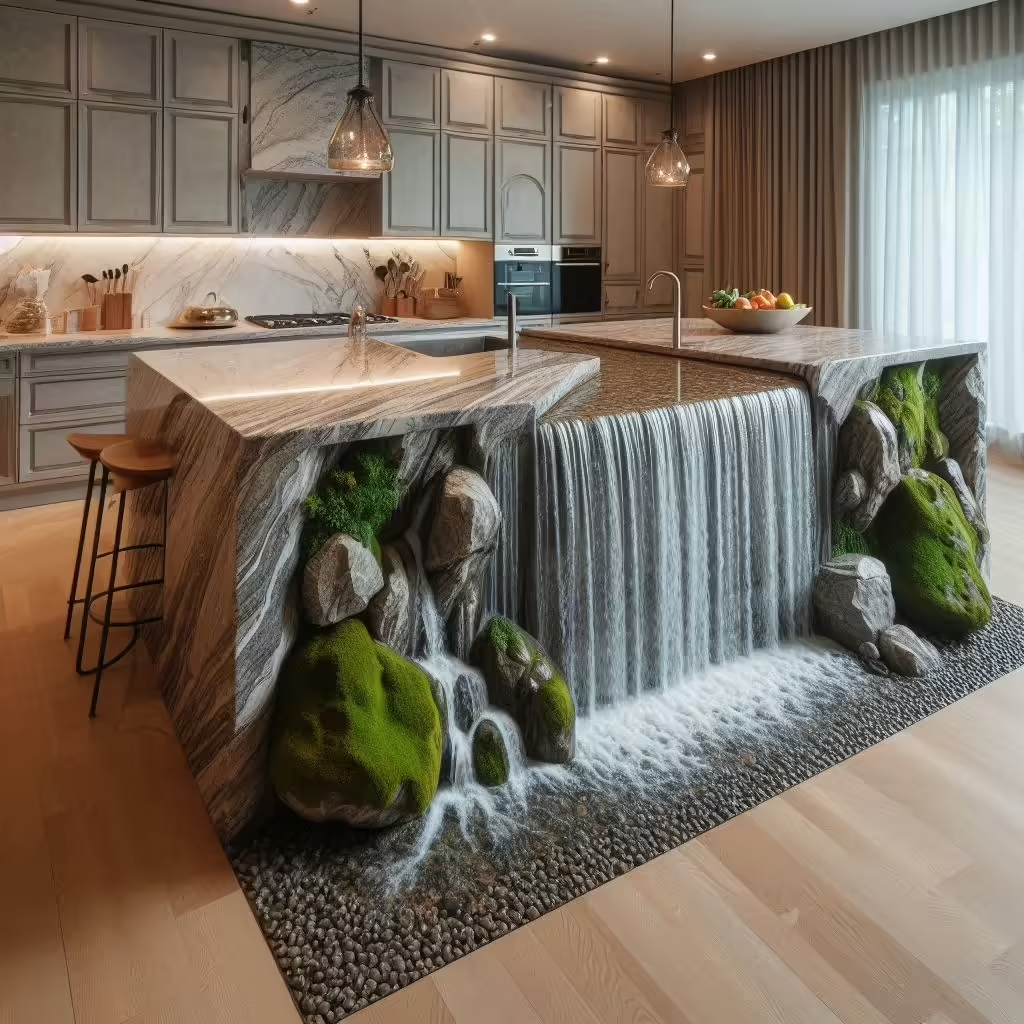
Monochromatic Elegance
Create a seamless and cohesive look by choosing a single color for both the waterfall island and the surrounding cabinetry. A white quartz waterfall island paired with white cabinets creates a clean, minimalist aesthetic that is both modern and timeless.
Contrast and Boldness
For a more dramatic effect, use contrasting materials and colors. A dark granite or black quartz waterfall island against lighter cabinetry can create a stunning contrast that draws the eye and adds depth to the kitchen.
Natural Stone Beauty
Highlight the natural beauty of stone by using marble or granite with prominent veining. The waterfall effect emphasizes the stone’s patterns, turning the island into a work of art.
Integrated Seating
Extend the waterfall countertop to create a breakfast bar or casual dining area. This design is perfect for open-concept kitchens, allowing for easy interaction between the kitchen and living areas.
Storage Integration
Incorporate storage solutions into the waterfall island. Include built-in shelves, cabinets, or drawers on the vertical sides to maximize the island’s functionality without compromising its sleek appearance.
Mixed Materials
Combine materials like wood and stone to create a unique waterfall island. For example, a quartz countertop with wooden sides can add warmth and texture, creating a balanced look that feels both modern and inviting.
How to Incorporate a Waterfall-Shaped Kitchen Island in Your Kitchen
Plan Your Space
A waterfall-shaped kitchen island requires careful planning to ensure it fits seamlessly into your kitchen layout. Consider the size of the island in relation to the overall space. It should be large enough to make an impact but not so large that it overwhelms the kitchen.
Choose the Right Material
The material you choose will significantly impact the island’s appearance and functionality. Consider factors like durability, maintenance, and cost when selecting the material. Quartz and granite are popular for their durability, while marble offers a luxurious, high-end look.
Coordinate with Kitchen Elements
Ensure that the waterfall island complements the other elements in your kitchen, such as cabinets, countertops, and flooring. Coordination of colors, textures, and finishes is key to creating a cohesive and harmonious design.
Hire a Professional Installer
Installing a waterfall-shaped kitchen island is a complex task that requires precision and expertise. Hire a professional installer to ensure that the countertop is cut, fitted, and secured correctly to achieve the seamless waterfall effect.
Incorporate Lighting
Highlight the beauty of your waterfall island with strategic lighting. Pendant lights above the island not only provide functional lighting for food preparation and dining but also enhance the island’s visual appeal.
Maintenance and Care Tips
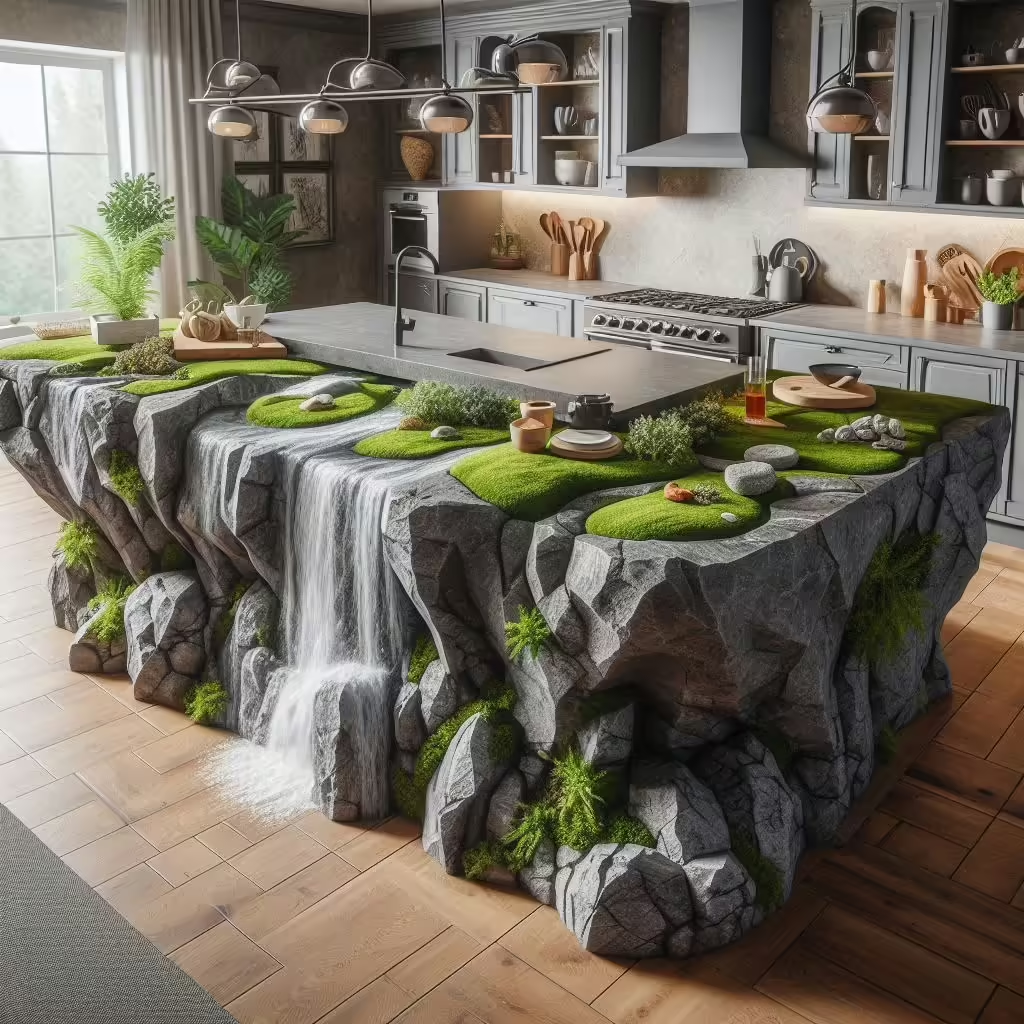
Regular Cleaning
To keep your waterfall-shaped kitchen island looking its best, clean the surface regularly with a soft cloth and a mild cleaner. Avoid using abrasive cleaners or scrubbers that can damage the surface, especially for materials like marble and wood.
Seal the Surface
If you have chosen a porous material like marble, granite, or concrete, ensure that it is properly sealed to protect it from stains and moisture. Follow the manufacturer’s recommendations for resealing to maintain the island’s appearance.
Prevent Heat Damage
Although materials like granite and quartz are heat-resistant, it’s still advisable to use trivets or hot pads when placing hot pots and pans on the island. This practice helps prevent potential damage and keeps the surface looking pristine.
Address Spills Immediately
To prevent staining, especially on more porous surfaces like marble and wood, wipe up spills immediately. Use a soft cloth to blot the spill and avoid rubbing, which can spread the stain.
Creating a Focal Point with a Waterfall-Shaped Kitchen Island
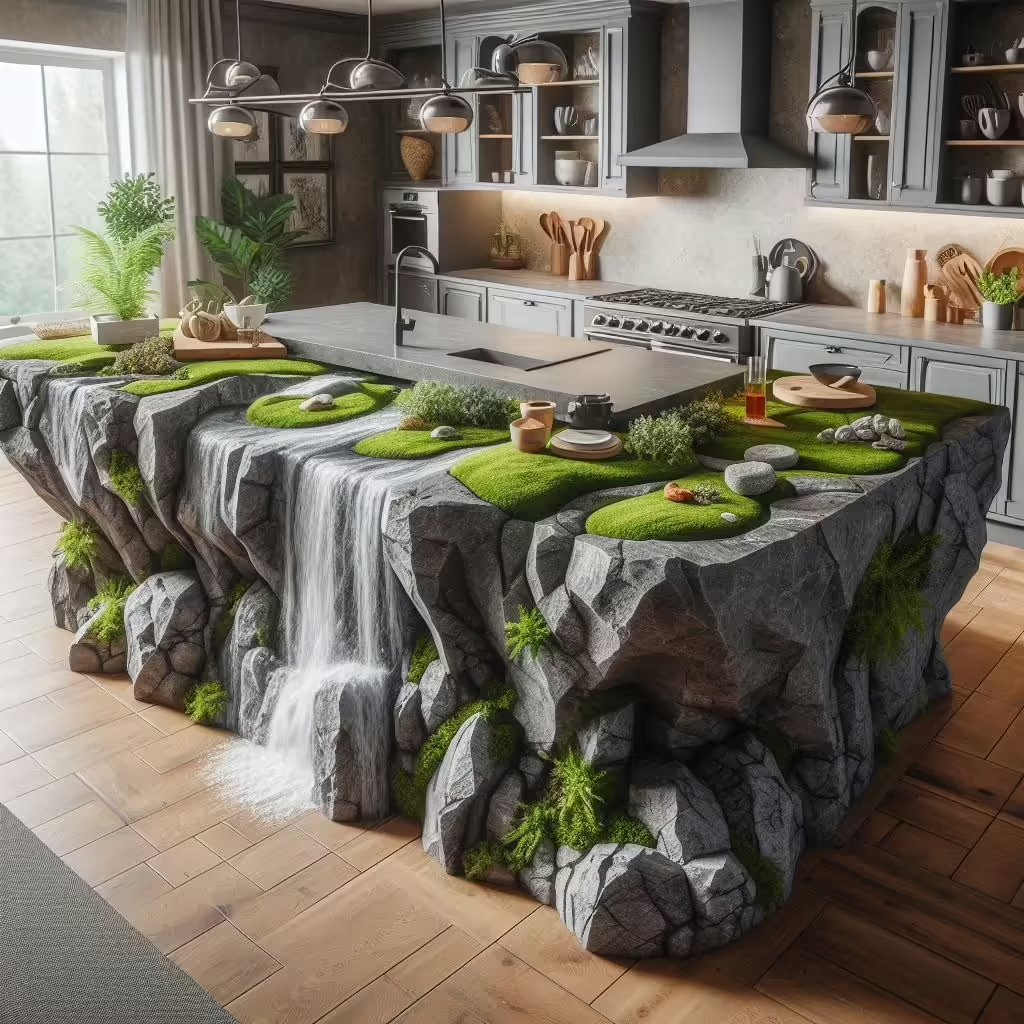
A waterfall-shaped kitchen island naturally becomes the focal point of any kitchen, drawing attention with its continuous lines and elegant design. However, the true beauty of this feature is its versatility. Whether your kitchen is a small, cozy space or a large, open-concept area, a waterfall island can be adapted to suit different layouts and styles. Here are some additional ways to use this feature to its fullest potential:
Enhancing Small Kitchens
In smaller kitchens, space is a premium. A waterfall-shaped kitchen island can maximize the available area by serving multiple functions. For example, you can design the island to include storage cabinets, a breakfast bar, and a food preparation area, all in one. The sleek, streamlined appearance of the waterfall edge also helps visually expand the space, making the kitchen appear larger and more open.
Adding a Sense of Luxury
If you aim to create a luxurious, high-end kitchen, the choice of material for your waterfall island can make a significant impact. Opting for premium materials like marble with dramatic veining or exotic stones like onyx can elevate the entire kitchen’s look. Pairing these materials with high-quality fixtures and appliances will create a cohesive, luxury kitchen design that feels both opulent and inviting.
Creating a Seamless Transition in Open-Concept Spaces
Open-concept kitchen designs benefit greatly from the waterfall-shaped kitchen island. The continuous lines and cohesive materials of the waterfall edge help blend the kitchen with adjacent living or dining areas. This design feature can create a visual bridge between spaces, fostering a harmonious flow and making the kitchen island the natural hub for social interactions.
Incorporating Appliances and Sinks
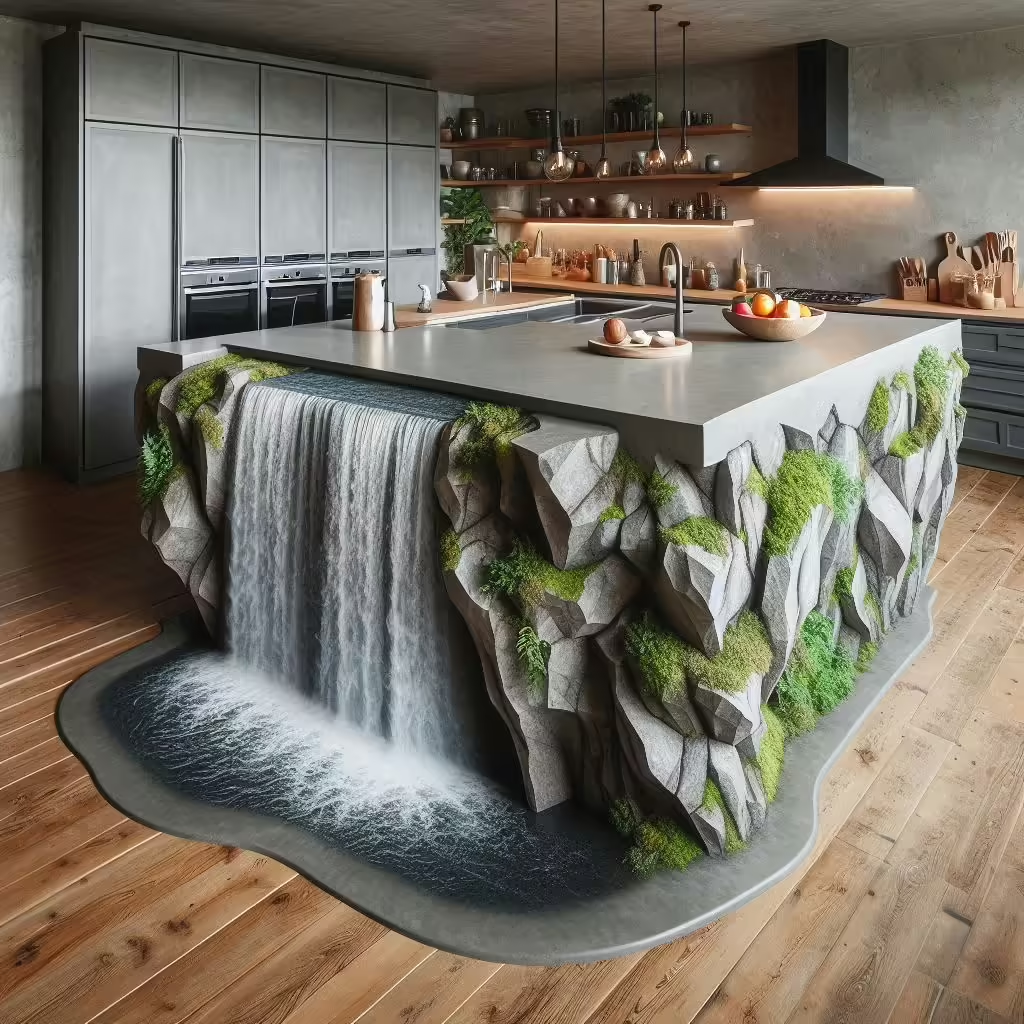
For a highly functional kitchen island, consider incorporating appliances and sinks into the waterfall design. Integrated cooktops, wine coolers, or a built-in sink can make the island the main workstation of the kitchen. When planning these integrations, ensure the waterfall design does not compromise practicality. Proper planning and installation are key to maintaining the island’s aesthetic while ensuring full functionality.
Mixing and Matching Finishes
Don’t be afraid to mix and match finishes on your waterfall-shaped kitchen island to create a more dynamic and personalized look. For instance, combining a polished quartz countertop with matte cabinetry underneath can create an eye-catching contrast. Adding elements like metallic accents, wood grain finishes, or textured surfaces can add depth and interest to the island.
Personalizing Your Waterfall-Shaped Kitchen Island
Personalization is one of the best aspects of incorporating a waterfall-shaped kitchen island into your kitchen design. Here are some ways to customize your island to reflect your personal style and needs:
Custom Edge Profiles
While the classic waterfall design features straight edges, you can customize the profile to suit your aesthetic preferences. Consider a beveled edge for a softer look or a mitered edge for a more dramatic effect. The edge profile can significantly change the island’s overall appearance, adding an extra layer of detail to the design.
Integrated Lighting Features
Incorporating LED lighting along the edges of your waterfall island can add an extra layer of sophistication and functionality. Under-counter lighting not only highlights the island’s design but also provides additional task lighting for food preparation and dining. Choose warm or cool lighting tones to match the ambiance of your kitchen.
Unique Material Combinations
Combine different materials to create a truly unique waterfall-shaped kitchen island. For example, pair a sleek marble countertop with reclaimed wood panels on the sides for a blend of modern and rustic elements. This approach allows you to infuse your kitchen with character and style while maintaining the island’s functional aspects.
Incorporating Smart Storage Solutions
To maximize the functionality of your waterfall island, integrate smart storage solutions. Hidden drawers, pull-out shelves, or built-in spice racks can be incorporated into the vertical sides of the island. This approach keeps the kitchen organized and clutter-free while preserving the island’s sleek, uninterrupted lines.
Extending the Waterfall Concept to Other Kitchen Elements
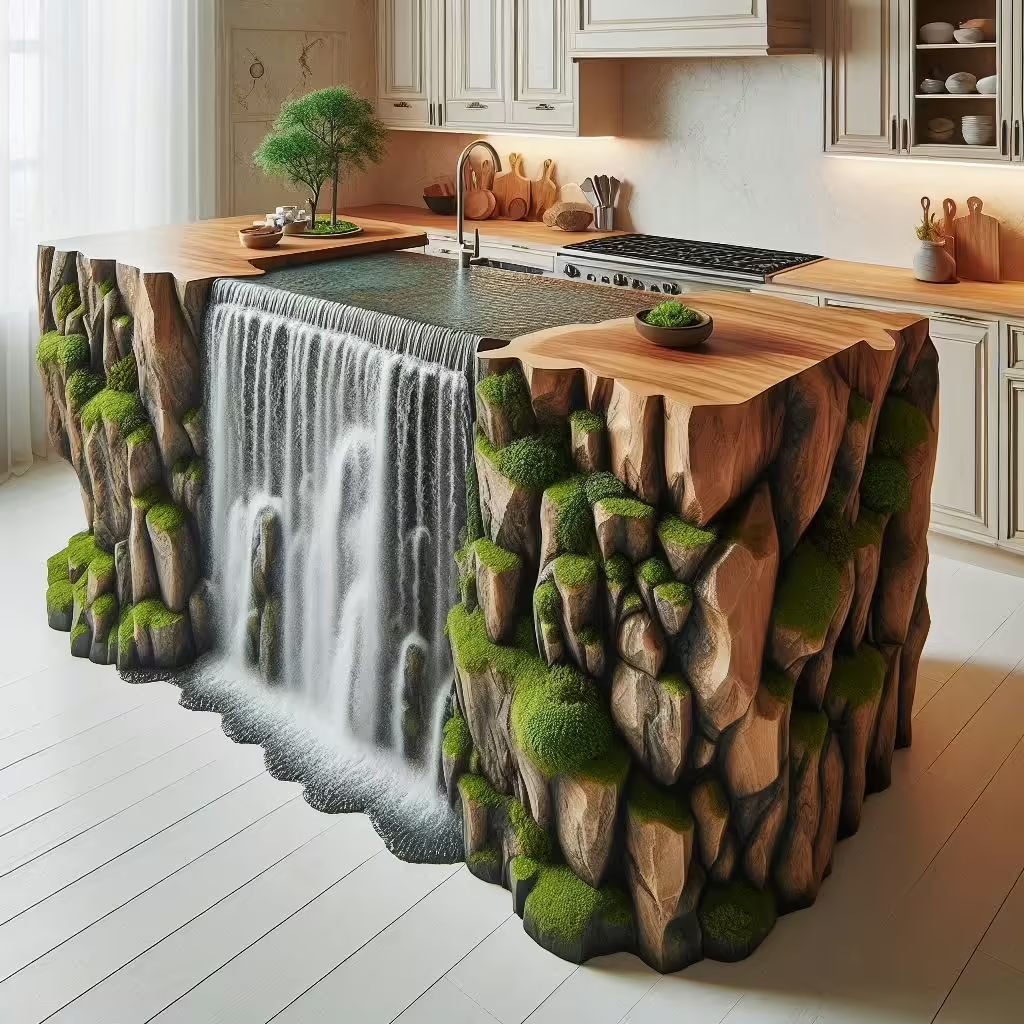
While the waterfall edge is most commonly associated with kitchen islands, the concept can be extended to other elements in your kitchen for a cohesive and modern design. Here are a few ideas:
Waterfall Countertops on Peninsulas
If your kitchen does not have room for a full island, consider incorporating a waterfall edge on a peninsula. This design can still provide a dramatic visual impact while offering additional workspace and seating.
Waterfall Edges on Dining Tables
For a seamless look, extend the waterfall concept to an adjoining dining table. A waterfall-edged dining table paired with the kitchen island can create a cohesive flow, especially in open-plan kitchen-dining spaces. This approach ties together the different functional areas, providing a consistent design language.
Waterfall Features on Sideboards or Buffets
If your kitchen layout includes a sideboard or buffet, applying the waterfall edge design to these pieces can create a unified aesthetic throughout the kitchen. This technique can be particularly effective in kitchens that open into dining or living spaces, providing a harmonious design flow.
Creating a Functional and Stylish Kitchen with a Waterfall Island
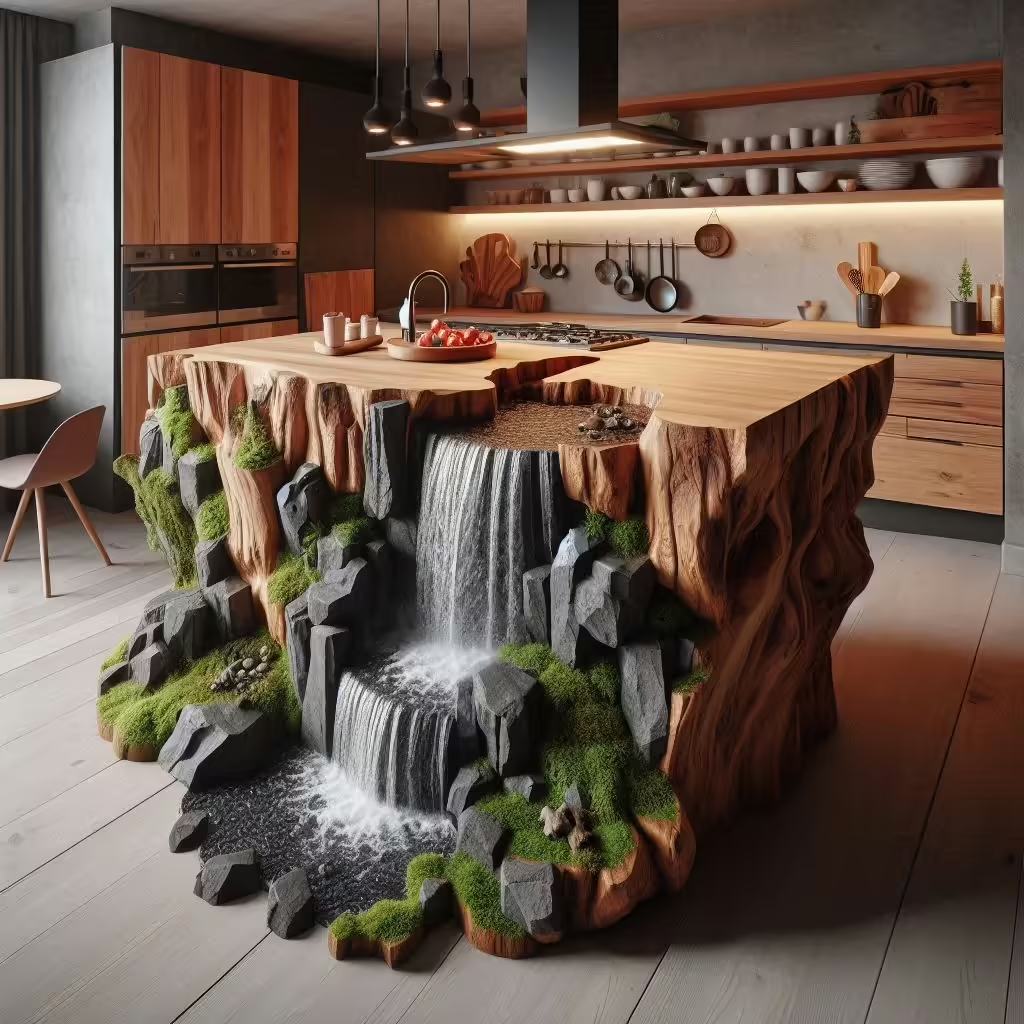
The allure of a waterfall-shaped kitchen island lies in its blend of style and functionality. While it undoubtedly adds a touch of modern elegance to the kitchen, its practical benefits make it an ideal choice for both everyday use and entertaining guests. The island serves as a central gathering point, bringing together cooking, dining, and socializing into one cohesive space.
Balancing Form and Function
When designing your waterfall-shaped kitchen island, it’s crucial to balance aesthetics with functionality. Here are some tips to achieve this balance:
- Consider the Workflow: Ensure that the island’s design does not hinder the kitchen’s workflow. It should enhance the work triangle (the relationship between the stove, sink, and refrigerator) for efficient movement within the space.
- Integrate Practical Features: While the waterfall design emphasizes a clean, uninterrupted look, it should still cater to your daily needs. Incorporating storage, seating, and appliances into the design can enhance the island’s utility without sacrificing style.
- Choose Durable Materials: Select materials that can withstand the wear and tear of daily kitchen activities. Quartz, granite, and engineered stone are excellent choices for their durability and low maintenance.
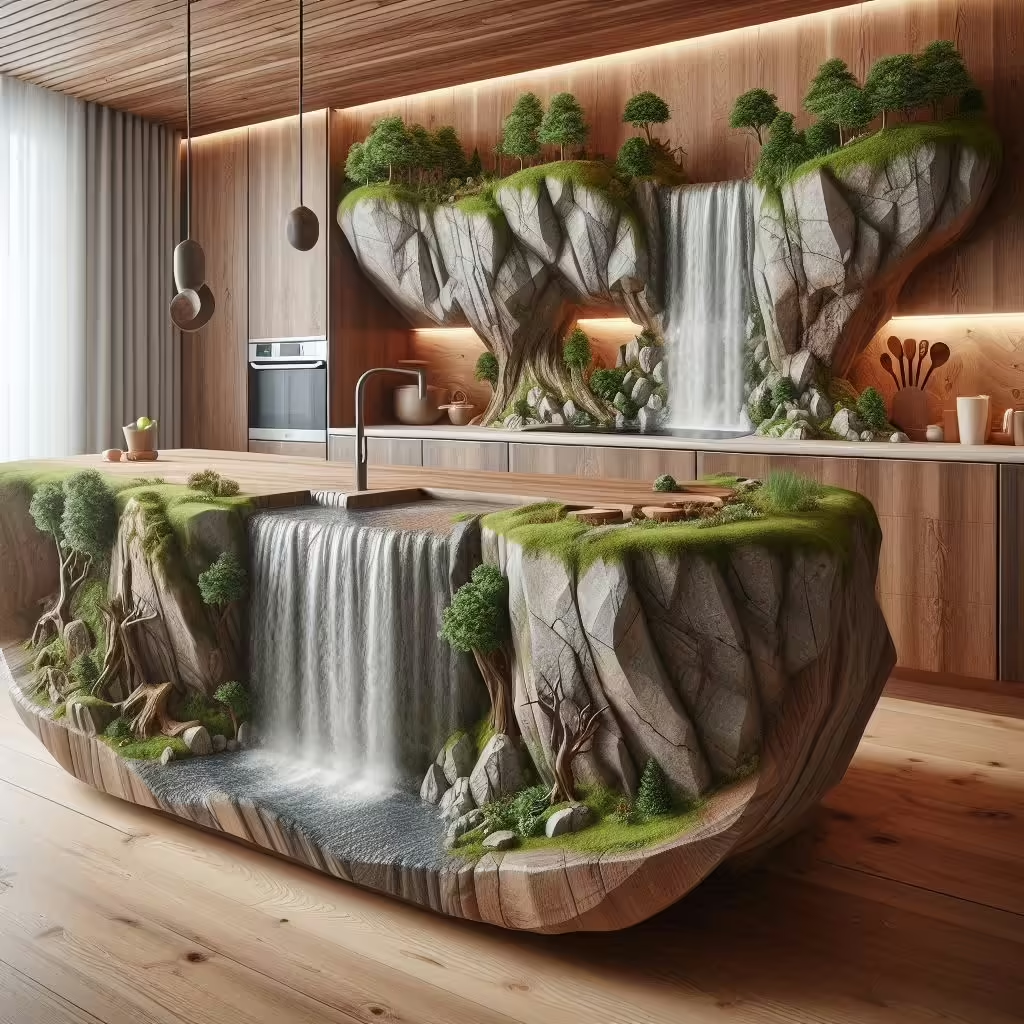
Conclusion
A waterfall-shaped kitchen island offers a perfect blend of aesthetic appeal and functional utility. Its sleek, continuous lines create a modern focal point that enhances the overall design of the kitchen. Whether you’re looking to add a touch of luxury with marble, embrace warmth with wood, or opt for durability with quartz, this design element is versatile enough to suit various kitchen styles and preferences.
By carefully planning the design, selecting the right materials, and considering the practical aspects of your kitchen layout, you can create a waterfall-shaped island that not only elevates the space visually but also enhances its functionality. Whether used as a dining area, a food preparation zone, or a stylish centerpiece, this type of island can transform your kitchen into a sophisticated, inviting environment for cooking, dining, and gathering.
Incorporating a waterfall-shaped kitchen island is an investment in both style and utility, offering a timeless design feature that will remain appealing for years to come. With thoughtful design and proper care, this stunning kitchen element will serve as the heart of your home, bringing together family and friends in a space that is as beautiful as it is functional.
